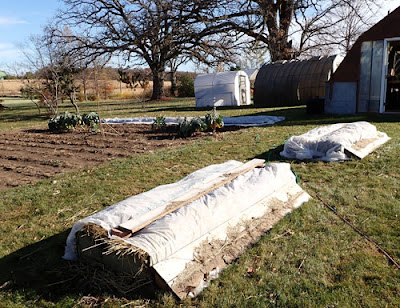It is not clear to me how I ever had time for a job. It is the end of October. By now, the semester would be in Week 11 of 16, and I have just finished the list of things I needed to do outside to get ready for winter. I have washed the pots and trays, cleaned the greenhouse, and pulled the spent vegetables from the garden. The landscape cloth is rolled up and stored, as are all the drip irrigation lines. I put the strawberries to bed by covering them with straw and row cover to keep the straw from blowing away. The garlic is planted and similarly covered with straw and row cover. How did I do all that when I only had weekends? (I miss my mom. She helped a lot.)
 |
| Two raised beds of strawberries (foreground), Brussels sprouts and garlic in the main garden. |
I am done with apples. I have dried apples, made and canned three batches of apple butter, and cooked gallons of applesauce. I started the applesauce process with modest intentions. I made enough for my needs and told myself that I’d done the last batch. But there were so many apples! I had the thought that I would share and made one more batch, definitely the last. The apples were just too good to let rot, so I made a third last batch. I mean it this time.
 |
| The third last batch: Six pints + one cup applesauce with applesauce pot and food mill to take out the lumps |
I can’t say for certain, but I think Lucky laid her first egg on Saturday. It is larger than the usual first pullet egg, but smaller than the average hen’s egg. Another indication was that we had two green/blue eggs in one day, which we haven’t seen since Goldie and Silvia started laying again.
 |
| Putative pullet egg from Lucky, upper left, with hen eggs for comparison |
Speaking of, Silvia is looking good, having grown back her beard feathers since her molt.
 |
| The newly-feathered Silvia |
In other signs of fall, the corn has been harvested across the road. I’m not sure what they were doing yesterday other than making a lot of noise and filling the air with dust. They took the corn the day before. Terry thought they were picking up stover (the parts of the corn plant that are not the ear).
 |
| Cleaning up the cornfield across the road |
The milkweed pods have dehisced, a fancy word for “split open.” Milkweed fluff is everywhere. And milkweed seedlings will be everywhere come spring.
 |
| Dehiscent milkweed pods |
Terry has decorated the front entrance with his pumpkins, Michigan holly, and Osage orange fruit. It looks very festive.
 |
| Home-grown seasonal decorations |
Happy Halloween!

















